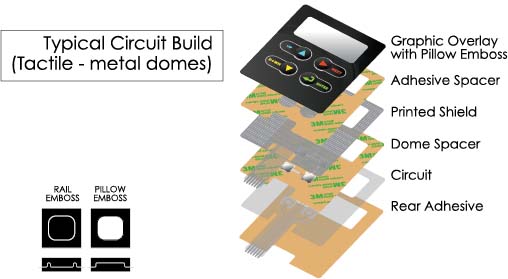Comprehending Membrane Layer Switches: The Secret to Trusted and resilient Controls
Membrane switches represent a critical aspect of contemporary user interface style, mixing functionality with resilience in different applications. As we explore the ins and outs of membrane buttons, it comes to be clear that their role in improving control systems is both profound and intricate, elevating questions regarding how best to leverage their capabilities in future developments.
What Are Membrane Layer Buttons?
Membrane layer switches are an advanced service in the world of customer interface technology, incorporating performance and style perfectly. These gadgets act as an interface in between users and digital systems, integrating a number of components right into a small format. Typically created from versatile, thin layers of materials, membrane switches are created to respond to touch, allowing individuals to interact with machinery and electronic tools successfully.
The primary aspects of a membrane switch consist of a published circuit layer, visuals overlay, and a spacer layer that stops unplanned activation. The graphic overlay can be tailored to show brand identification or customer preferences, enhancing looks while ensuring use. Membrane layer buttons are typically utilized in numerous applications, including clinical devices, consumer electronic devices, and industrial devices, owing to their sturdiness and resistance to ecological factors such as wetness and dirt.
Among the essential advantages of membrane layer buttons is their capacity to withstand deterioration, making them ideal for high-traffic settings. Furthermore, they are light-weight and need marginal area, enabling for innovative designs in item development. Generally, membrane layer switches over stand for a efficient and useful choice for modern electronic user interfaces, weding technology with user-centric layout principles.

How Membrane Switches Over Job
The operation of membrane layer switches joints on a straightforward yet reliable system that converts individual input right into electronic signals. When a user presses the button, the leading layer warps, permitting a conductive aspect in the circuit layer to make contact with an equivalent conductive pad on the bottom of the graphic overlay.
The layout of membrane layer buttons can differ, however they usually integrate domes or tactile elements to supply feedback to the user, boosting the general experience. The materials made use of in membrane buttons, such as polyester or polycarbonate, add to their durability and resistance to environmental factors, consisting of dampness and dirt. The published circuits are typically encapsulated, which protects them from wear and tear over time.

Advantages of Membrane Buttons
One of the main advantages of membrane switches is their convenience in layout, allowing them to be customized to meet specific user needs and aesthetic requirements. This adaptability includes various markets, where different forms, sizes, and shades can be utilized to boost user interaction and visual appeal.
Furthermore, membrane buttons are recognized for their durability. Created from durable products, they are resistant to dirt, dampness, and physical wear, which considerably expands their life-span compared to standard mechanical switches. This durability makes them specifically appropriate for high-traffic environments and applications needing long life.

Additionally, membrane layer switches use a structured account, causing a thinner design that can be integrated right into numerous devices without including mass. This function not just improves the visual allure best site however additionally adds to a more ergonomic item layout.

Applications of Membrane Layer Buttons
Flexible and easy to use, membrane switches find applications across a variety of industries, consisting of clinical gadgets, customer electronics, and industrial equipment. In the medical area, these buttons are integral to tools such as diagnostic devices, patient surveillance systems, and mixture pumps, where integrity and simplicity of cleansing are critical. Their ability to keep and endure severe atmospheres capability makes them perfect for such applications.
In consumer electronic devices, membrane layer buttons are used in products like microwaves, washing machines, and push-button controls - membrane switch. Their smooth layout permits intuitive interface, improving the total user experience while supplying durability and resistance to deterioration
Industrial devices likewise profits from membrane layer buttons, specifically in control panels for equipment and automation systems. These switches supply defense versus dirt and dampness, making certain consistent performance in challenging settings. Additionally, their customizable attributes permit this content makers to tailor them to specific functional requirements, improving effectiveness and performance.
Selecting the Right Membrane Layer Switch Over
When choosing a membrane switch, it is important to think about various aspects that influence performance and suitability for certain applications. The main considerations consist of environmental conditions, tactile feedback, resilience, and style requirements.
First, assess the operating environment; buttons revealed to moisture, chemicals, or extreme temperatures need details materials to make certain durability and performance. Next, examine the demand for responsive feedback. Relying on user communication, some applications might gain from a responsive action to verify activation, while others might prefer a non-tactile layout for visual factors.
Sturdiness is an additional vital variable; membrane layer switches need to be developed to withstand regular usage, effects, and abrasion. Ensure the picked button can endure the anticipated lifecycle, especially in high-usage situations.
Conclusion
In final thought, membrane layer changes serve as essential components in the design of trusted and sturdy control systems across various industries. The versatility of membrane layer changes enables for tailored remedies that fulfill specific functional requirements, enhancing their relevance in modern innovation.
Membrane layer switches represent a vital element of contemporary user interface design, blending functionality with strength in different applications.Membrane layer switches are an innovative option in the world of customer interface innovation, incorporating capability and design effortlessly. Generally created from versatile, thin go right here layers of materials, membrane layer buttons are designed to react to touch, allowing customers to interact with equipment and digital devices effectively.
The design of membrane buttons can differ, but they often include domes or tactile components to provide feedback to the customer, improving the general experience.In verdict, membrane changes offer as essential components in the design of long lasting and trustworthy control systems across numerous sectors.